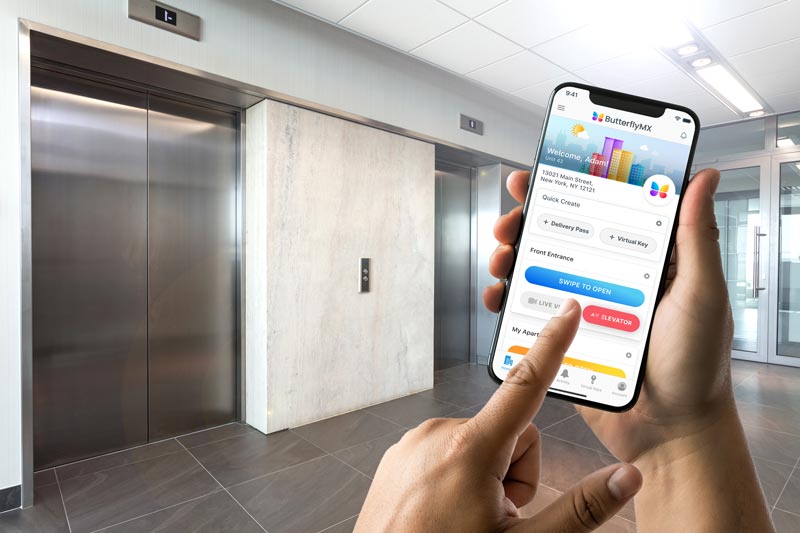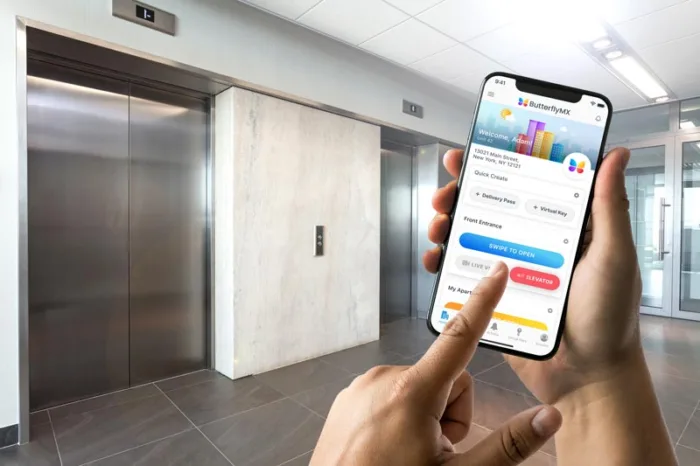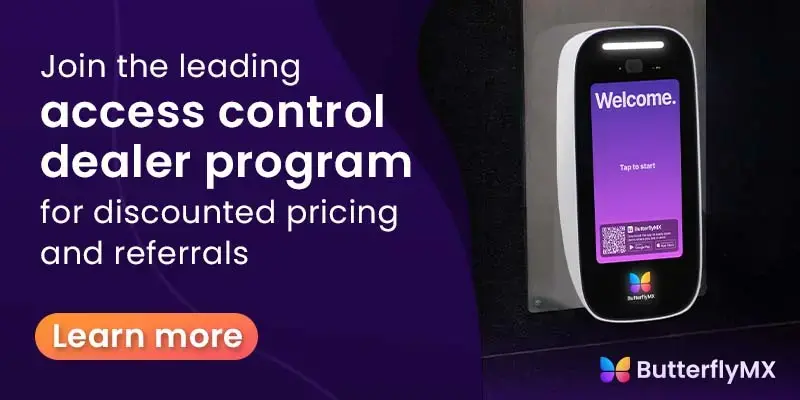Key takeaways:
- Elevator access control systems restricts floor access, improving building security.
- Types of elevator control systems include single elevator control, elevator banks, and smart elevators for optimized security..
- The key components of these systems are access readers, control panels, and security features to manage permissions.

When thinking about access control for your property, elevators are probably the last thing that comes to mind. However, elevators provide access to every floor within your building. So, it’s vital to incorporate an elevator access control system.
Read on to discover what elevator access control is, how it works, its benefits, and the best system available.
In this guide, we’ll cover:
- What is elevator access control?
- How elevator access control works
- Types of elevator access control systems
- Benefits of controlled access for elevators
- Best elevator access control system
What is elevator access control?
Elevator access control regulates who can call your building’s elevators and/or access certain floors within your building.
An elevator ACS consists of hardware and software that operates the elevators within a building and authorizes access to specific floors. And just like building entrance doors, elevators are high-traffic areas that may need controlled access.
What are the 3 elevator control systems?
In general, there are three main types of elevator access control:
- Single elevator access control operates just one elevator in a building. Smaller buildings with fewer floors and fewer tenants, like low-rise apartment buildings, have this system. Access control systems for single elevators allow you to set certain times for tenants to use the elevator and restrict it from stopping on specific floors.
- Elevator banks are found in larger buildings and are used to move multiple people in multiple elevator cabs. In high-rise and enterprise-class commercial buildings, elevator banks restrict tenants’ access to certain floors — namely, the floor where their office suite is located.
- Smart elevators are the modern way of access control for elevators. They’re found in new multi-tenant buildings with 10 or more floors and rely on a centralized designation control system (DCS). With DCS, tenants key in which floor they go before entering the elevator cab. So, no traditional up/down buttons are placed in front of elevators. Furthermore, it’s common not to see buttons inside smart elevator cabs.
How elevator access control works
Elevator access control works differently depending on the specific type of system you install. However, it generally authenticates a user’s credentials before the elevator can go to a particular floor.
Access control systems for elevators have three main components:
- Control buttons: Even in smart elevators, the cab will still have a few essential button functions. Elevator controller buttons include the door open, close, emergency call, and emergency stop buttons.
- Access reader/authenticator: This can be an RFID reader, biometric scanner, or elevator access control keypad. The access control elevator interface determines whether or not a tenant has the appropriate credentials to use the elevator and access certain floors.
- Access control panel: The control panel is the system’s brain. It stores tenant information and access permissions. This physical device is stored onsite or cloud-based software you can access online.
How do you connect an access control system to an elevator?
Connecting an access control system to an elevator depends on the elevator, the building’s infrastructure, and your chosen installer.
The general steps for connecting your elevator ACS are:
- Decide how you’ll connect the elevator relays to the system. This entails planning how the elevator will respond in an elevator floor lockout.
- Power the access reader device. Depending on the specific device, you may power it via a Power over Ethernet cable, USB, or an ordinary power cord.
- If it’s a cloud-based system, then you’ll connect it to the internet. If you’re using a PoE cable, it’s already connected to the internet.
- And finally, connect the relays and access reader to the control panel. The system is ready to be used once the elevator access control wiring is complete.
Types of access control configurations for elevators
There are also different types of access control configurations. Similar to the various ways access control systems restrict which rooms a tenant or guest can access, the same applies to elevator security systems.
The four main elevator access control configurations are:
- Private elevator for general access to any floor. Tenants need authorization to call the elevator in the lobby. But once inside the elevator, they can select any floor to access. An access reader, such as an elevator access key card or key fob scanner, is installed for authorized users to call the elevator.
- Public elevator with private access to selected floors. In this configuration, everyone can call the elevator using the call button in the lobby. However, they need to scan their credentials on an RFID reader to access certain floors inside the elevator cab.
- Private elevator with private access to selected floors. Tenants need authorized credentials to call the elevator and select desired floors once inside the cab. Typically, each tenant has access to particular floors. In this configuration, access readers are installed in the lobby and inside the elevator.
- Destination (or zoned) control systems. Also referred to as zoned elevator controls, this system only allows elevators to be called using the destination operating panel (DOP). So, the access reader is connected to the DOP, and the elevator system automatically selects the designated floor when tenants scan their credentials.
Does ButterflyMX work on elevators?
Yes, ButterflyMX works on elevators.
In fact, ButterflyMX elevator controls are designed to limit property access to residents, tenants, guests, and delivery drives. Commercial and multifamily properties can use ButterflyMX elevator controls with the access control system or video intercom.
When someone uses their credentials to access the property, the elevator only permits them to access the assigned level. For residents, the level would be that of their unit, whereas tenants can reach their office level.
Furthermore, guests who are let inside remotely may only access the floor of the tenants who granted them access. Thus, you can maintain the security and safety of your property, knowing guests have limited access.
Types of access control systems for elevators
Take your building security to the next level by installing a new elevator ACS. You can choose from various systems, but the one you should choose depends on your building size, type and number of elevators, and whether you want wired or wireless systems.
The common types of elevator access control systems are:
- Mobile elevator access control
- Elevator access control keypad
- Elevator access control card readers
- Cloud-based elevator management system
Mobile elevator access control
Mobile-based elevator access control is the best way to future-proof your building. Rather than requiring physical badges or key fobs, mobile elevator access control systems use smartphone apps or other mobile devices to allow access. This system is convenient and straightforward for tenants to use and provides elevators with robust security.
As a touchless access solution, smartphone-based elevator controls communicate with the tenant’s phone to check their credentials and call the elevator. Mobile credentials typically assign users to specific floors, preventing them from accessing floors they shouldn’t go to.
Elevator security keypad
Elevator keypads require users to enter a passcode or PIN to access the elevator controls. A benefit of keypads is that you don’t need to issue key cards or fobs to tenants, making it a cost-effective option.
However, a downside to keypads is that it’s easy for tenants to share their access or PIN codes with others, posing a security risk. Additionally, keypads can be cumbersome for bigger buildings because it takes time for each person to type in their PIN codes, making the elevator ride longer.
Elevator card readers
Another commonly used system is elevator RFID access control, which involves swiping or scanning a key card or fob at the RFID card reader inside the elevator cab. After scanning their credentials, tenants can press the elevator buttons to go to their intended floor.
Although this system is commonly used, it doesn’t provide strong security. Because key cards and fobs can easily be shared or lost, unauthorized people can access restricted floors without hassle. Another pitfall of elevator card readers is that they often require intensive wiring, which can get expensive, especially if rewiring is needed.
Cloud-based elevator management system
For the best elevator security and access control, choose a cloud-based system. Both commercial and residential properties should be agile enough to respond to security threats quickly. Cloud-based elevator access control allows you to respond to any event in real time from anywhere with internet access. Because cloud-based systems allow remote management, administrators can access employees and visitors from anywhere, anytime.
What’s more, cloud-based systems with cameras double as video access control with auditing features. As such, you can view detailed reports of who accessed which floors and who used certain credentials at specific times. This way, you can quickly review access events during a security breach.
Benefits of enabling elevator access control
Installing cloud-based elevator access control systems has many security and convenience benefits. If you own or manage a building with elevators, consider controlling access to them in addition to doors and gates.
Here are some of the benefits of enabling elevator control:
- Easy visitor management
- Robust building security
- Integrations with other access control systems
- Prevents overcrowded elevator cabs
Easy visitor management
A cloud-based elevator ACS empowers tenants to call the elevator for their visitors upon arrival. Also, some systems allow tenants to assign Visitor Passes to their guests in advance to access the elevators to go to their designated floors. This way, there’s no need for tenants to go downstairs to bring their guests up to their office or apartment.
Robust building security
Because an elevator security system controls which floors tenants can access and at what time, it improves security. In addition to door entry systems and lobby turnstiles, requiring an elevator card or mobile credentials adds another layer of security and protection to your building. This way, intruders have less of a chance of entering the building and up to restricted floors.
Integrations with other access control systems
In an IoT-based society, where the internet powers automation, having a cloud-based elevator ACS simplifies property access. You can integrate intercom systems, door keypads, and other proptech devices with elevator access controls to facilitate a seamless tenant experience. This way, tenants can manage all aspects of property access within one mobile app.
Prevents overcrowded elevator cabs
Elevator access control paired with smart elevators can reduce long wait times and prevent overcrowded elevator cabs. You can program the system to cluster tenants going to the same or nearby floors together so that each elevator trip is time-efficient. This also reduces the number of people that enter the elevator cab, preventing over-packing elevators and frustrating tenants.
Best elevator access control system
If you already have ButterflyMX products in your building, then complete the access experience with our ECS. Otherwise, if you’re starting to look into access control systems for your property, remember to include elevator controls.
In a ButterflyMX building, when visitors enter the building using the video intercom, the elevator controls automatically unlock your fobbed elevators for a set amount of time, allowing visitors to call the elevator and select the floor they need access to.
Moreover, a ButterflyMX-enabled front desk station empowers you to manage access to your elevators from anywhere. So, staff can easily grant or restrict access to certain floors.
Not to mention, the ButterflyMX ecosystem integrates with several third-party property management systems and smart building solutions. As a result, you benefit from a centralized property management solution, reducing operation costs and streamlining staff workflows.
Above all, the ButterflyMX OS is accessible through a mobile app or online dashboard, simplifying property access management. From a convenient web-based dashboard, your property staff can update the tenant directory, manage access credentials and permissions, review door release and elevator logs, and control every other aspect of the system.








